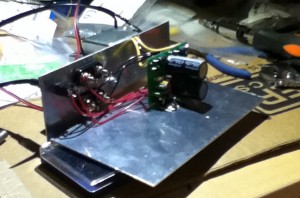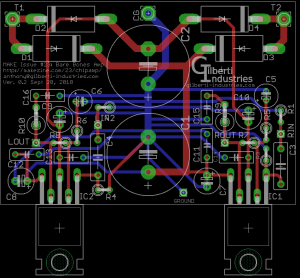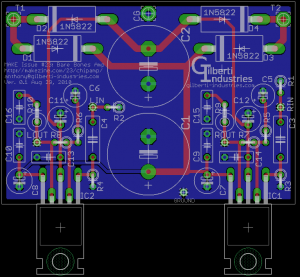What a Test!
It works. Wow does it work!
Went to the campus wood shop after class to cut the aluminum plates for the amplifier’s cabinet. It took several hours of cutting, filing, and drilling to create the three plates making up the bottom, the back, and the switch and fuse panel. However, it was worth it. With the plates fabricated, I had a basic chassis to attach the amplifier and its many support parts to.
I’ve been at it since marching band class ended 9:30 last night. Only finished it within the last hour. While the MAKE Magazine article suggested connecting a dummy load first and measuring the voltage across it, I could not get that to work. Instead, I jumped right into it and connected the amp to the speakers left over from my old boom box. I was greeted by a 440Hz sine wave coming out of Pure Data. I quickly moved on to a more “entertaining” test.
Wow. Just wow. Ross Hershberger wasn’t lying when he said this thing sounds like a million bucks. It’s just like listening to my dad’s 600W behemoth of a stereo back at home. If I closed my eyes, I could imagine myself front and center at an ELO concert, afros bobbing in time to “Latitude 88 North”. This amplifier is well worth the pain.Unfortunately, my joy is tempered somewhat by two things. First off, I still don’t have a cabinet, and the amp takes up a fair bit of space on my work bench. Second, when there is no input signal, there is a bit of a low hum. It’s going to get old fast, and I don’t think I have the skills or know how to track down the source of the hum myself, but just having great sounding music in my dorm again more than makes up for it.
Have you built your own Bare Bones Amp? Maybe you have some insight into my noise problem. Feel free to post your comments and suggestions below.
EDIT: Just found one potential source of interference. I think the amplifiers may be creating a ground loop (a path in which two ends of a grounded node come back to each other). The mounting hardware I ordered to heat sink the ICs came with metal rather than nylon nuts and bolts. I figured it would be okay, however, because the kit also included a plastic washer that fits within the IC’s mounting holes, which I assumed was to keep the bolts from making contact with the IC chassis. Turns out the washer is doing bupkis. I’ll order some nylon hardware later this week and hope for the best. If you know any other reasons for the noise, however, by all means share. This may not be the only problem with my design.
Also, I found out why my initial tests failed: I had my voltohm meter set for amps instead of volts. Stupid.
9



